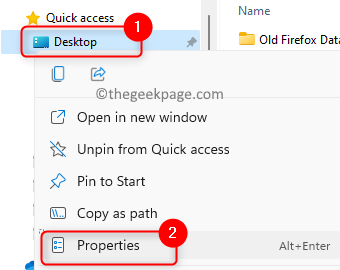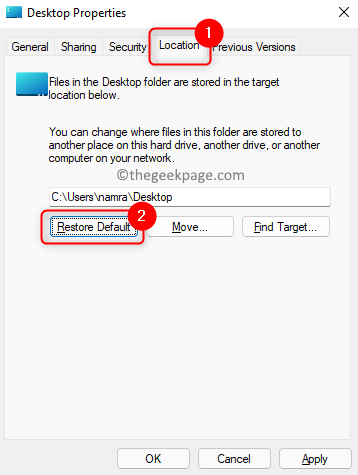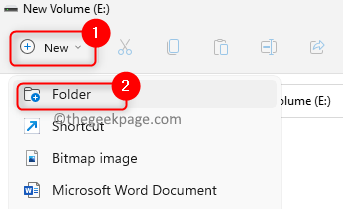Many users have encountered an error when trying to reset some of the user folders (like Desktop, Downloads, Pictures, Music, and so on) default location using the File Explorer. Generally, this error is reported when you make an attempt to change the folder’s location and it doesn’t work so you try to restore it back to default. The error message that is displayed to the user is:
Failed to build the list of regular subfolders under “D:\System Volume Information”.
Acces is denied.
Possible reasons for this error are:
- Lack of administrative permissions
- Issues during the transfer of folders between drives
- The mapping of the drive folders is corrupted.
In this article, you will see a list of solutions that will help you overcome this error on your Windows PC.
Fix 1 – Attempt a Folder Location Reset and Restart
1. Go to the folder that is giving this error. Right-click on it and choose Properties.
2. Select the Location tab.
3. Click on the Restore Default button.
4. In the window that appears, click on No.
5. Restart your system. Check if the problem is resolved.
Fix 2 – Make a New Folder and Point to the Location
Assume you are trying to move the Desktop folder from the C drive to another drive (namely D or E). There can be an issue with this folder move like the complete drive may be displayed on the desktop. When you try to reset the folder’s default location to get rid of this problem you see the error. So you can try ignoring the problematic folder by creating another folder, moving the contents into it, and then pointing to the location.
We will detail the steps considering that we are trying to move the Desktop folder in C Drive to E drive. Make changes based on the folder and drive you are trying to move.
1. Open File Explorer (Windows + E). Navigate to the drive to which you were trying to make the folder movement. We have considered E drive here.
2. Click on the New menu item at the top to create a new item in the E drive. Select the option Folder.
3. Name the folder, here we will name it as Desktop.
4. Copy the files in the Desktop folder in the C drive that you were trying to move using Ctrl + C.
5. Go to the newly created folder (Desktop in E drive) and paste the files here using Ctrl + V.
6. In the File Explorer’s left pane, below the section named Quick access, you will see the Desktop folder. Right-click on it and choose Properties.
7. In the Properties window, go to the Location tab.
8. Click on the Move… button.
9. Go to the location where the new folder is created. Here the location is E:\Desktop.
This location will change based on where the new folder was created by you in Steps 1 and 2.
10. Click on Apply and then on OK.
11. Reboot your PC. Check whether the folder with the issue is pointing to the correct location.
Fix 3 – Clear Disk Space
1. Use the Windows and R keys to open the Run dialog.
2. Type ms-settings:storagesense to open the Windows System Storage Settings.
3. Here, turn on the toggle associated with Storage sense under Storage Management.
4. Then click on Show more categories to view the storage usage and to clear up storage like Temporary files.
5. Click on Temporary Files. It will display the list of files that can be removed.
6. Check the boxes associated with the Temporary Files storage that you want to clear and then click on the Remove files button.
7. In a similar manner, you can free up storage from other categories like Pictures, Mail, Documents, Videos, and so on.
8. Now check if this has helped fix the error.
Fix 4 – Take Ownership of the Folder
1. Press Windows + E to open File Explorer.
2. Right-click on the folder that is causing this issue and select Properties.
3. Go to the Security tab.
4. Click on the Edit button to change the permissions. Click on Yes if prompted by User Account Control.
5. In the Permissions window, click on Add… to add permissions for another user or group.
6. Click on the Advanced button in the Select User or group window.
7. In the new window that appears, click on Find Now…
8. Select Everyone in the search result at the bottom. Click on OK.
9. You will see Everyone under Enter the object name to select. Click on OK.
10. Under Permissions for Everyone, make sure to check the box next to the option Full control below the Allow column.
11. Click on Apply and then on OK to get the changes into effect.
12. Check if the problem with the folder has been resolved.
Fix 5 – Unmerge User Folders and Restore to Default
At times, there are situations wherein you may have dragged and dropped a user folder (like Desktop, Documents, etc) into another user folder. In this case, you need to unmerge the folders and then restore them to their default location.
A. Unmerge the User Folders
1. Press Windows + R to open Run.
2. Type regedit and click on OK to open the Registry Editor.
3. Navigate to the path mentioned below.
HKEY_CURRENT_USER\Software\Microsoft\Windows\CurrentVersion\Explorer\User Shell Folders
4. Once you are in User Shell Folders, you will see a list of items with the same name as the user folders like Desktop, Music, Pictures and so on. Consider that we are having a problem with the Downloads folder.
5. Double-click on the item {374DE290-123F-4565-9164-39C4925E467B} in the list. This multi-string value is key for the Downloads folder in the Registry.
6. Make sure the Value data field is set to %USERPROFILE%\Downloads. Click on OK.
Note: In a similar manner, if you are having this issue with any other user folder, change their existing value data field with the default values indicated in the list below
Desktop – %USERPROFILE%\Desktop
Documents – %USERPROFILE%\Documents
Favorites – %USERPROFILE%\Favorites
Music – %USERPROFILE%\Music
Pictures – %USERPROFILE%\Pictures
Videos – %USERPROFILE%\Videos
7. Reboot your system.
B. Restore to Default Location
1. To open File Explorer hold the Windows + E keys together.
2. Right-click on the Downloads folder in the left pane and choose Properties.
3. Go to the Location tab.
4. Click on the Restore Default button.
5. Now click on Apply and then on OK.
6. You will see that the location of the Downloads folder will now be restored.
Thanks for reading.
You must now be able to reset your folder location to the default path without seeing the error message. Comment and let us know the fix that worked for you.



